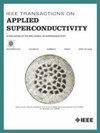用于稳态大电流应用的混合高温超导导体的研制与测试
IF 1.8
3区 物理与天体物理
Q3 ENGINEERING, ELECTRICAL & ELECTRONIC
引用次数: 0
摘要
第二代稀土REBCO高温超导体具有较高的临界电流密度和较高的临界磁场。高温超导材料有可能产生克服低温超导体限制的磁场。将5条无绝缘(NI)的高温超导带(GdBCO, SUNAM Korea,宽度为4mm)焊接到铜稳定剂中,开发出了混合高温超导体(HHTS)。另外,在室温和液氮(LN2)条件下对5条不含稳定剂的NI-HTS条进行了测试。对于高温超导带,在0.08 V时达到270 a的最大稳定电流(LN2温度下),超过该电流急剧下降。由压降计算出的临界电场(Ec)为14 μV/mm。在0.2 V电压和6.8 μV/mm电场条件下,hts的载流能力可达1000 a。通过在横截面上使用h公式,施加500到1000 A的电流,同时将稳定器宽度改变为7、9和12 mm,对HHTS进行了模拟。结果表明,稳定的电流传导高达1000 A。铜基体在冷却系统中断时提供稳定性,并且HHTS中的电场允许在更高的电流下运行,在电压控制和冷却效率方面具有优势。本文章由计算机程序翻译,如有差异,请以英文原文为准。
Development and Testing of Hybrid HTS Conductor for Steady-State High-Current Applications
Second-generation rare Earth REBCO high-temperature superconductors (HTSs) exhibit a high critical current density and a higher critical magnetic field. HTS materials have the potential to generate magnetic fields that overcome the limitations of low-temperature superconductors. A hybrid high-temperature superconductor (HHTS) was developed by soldering five HTS strips (GdBCO, SUNAM Korea, and 4 mm in width) without insulation (NI) into a copper stabilizer. In addition, five NI-HTS strips without stabilizers were tested at room temperature and in liquid nitrogen (LN2). For the HTS strips, a maximum stable current of 270 A (at LN2 temperature) was achieved at 0.08 V, beyond which the current dropped sharply. The critical electric field (Ec) calculated from the voltage drop was 14 μV/mm. The HHTS demonstrated a current-carrying capacity up to 1000 A at an applied voltage of just 0.2 V and a corresponding electric field of 6.8 μV/mm. The simulation of HHTS was performed by using H-formulation at the cross section, applying currents from 500 to 1000 A, while varying the stabilizer width to 7, 9, and 12 mm. The results indicate stable current conduction up to 1000 A. The copper matrix provides stability during interruption in the cooling system, and the electric field in the HHTS allows operation at higher currents, offering advantages in voltage control and cooling efficiency.
求助全文
通过发布文献求助,成功后即可免费获取论文全文。
去求助
来源期刊

IEEE Transactions on Applied Superconductivity
工程技术-工程:电子与电气
CiteScore
3.50
自引率
33.30%
发文量
650
审稿时长
2.3 months
期刊介绍:
IEEE Transactions on Applied Superconductivity (TAS) contains articles on the applications of superconductivity and other relevant technology. Electronic applications include analog and digital circuits employing thin films and active devices such as Josephson junctions. Large scale applications include magnets for power applications such as motors and generators, for magnetic resonance, for accelerators, and cable applications such as power transmission.
 求助内容:
求助内容: 应助结果提醒方式:
应助结果提醒方式:


